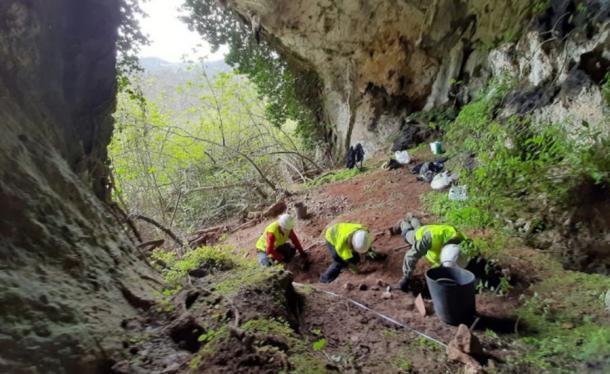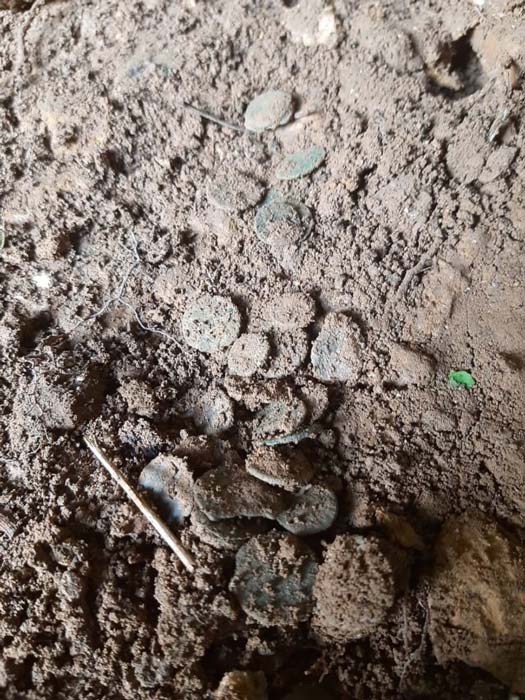A badger desperately hunting for food during the harsh winter of 2021, when Storm Filomena deposited snow across the Iberian Peninsula , has accidentally uncovered a substantial Roman coin hoard in a cave in northern Spain. The cave is located in Berció, a parish in the municipality of Grado in the Spanish province of Asturias, reports the newspaper El Pais .

Three archaeologists excavate the location where the Roman coin hoard was unearthed, first by a badger. (Consejería de Cultura del Principado de Asturias )
Largest Roman Coin Hoard on Record
The 209 coins unearthed by researchers following up on the badger’s “discovery” form the largest Roman coin hoard found so far in northern Spain. The complete report of the find, accessible on Academia.edu, has been published in Prehistory and Archaeology Notebooks of the Autonomous University of Madrid .
The researchers believe they are part of an even bigger Roman coin hoard, the remaining part of which may not exist any longer due to natural erosion. The Roman-era coins date to between the third and fifth centuries AD and originated in places as far away as the ancient cities of Antioch and Constantinople (present-day Istanbul) in Turkey, Thessaloniki in Greece, London in England and Lyon in France. They were minted between the reigns of Emperor Carus (282 to 283 AD) and Emperor Valentinian III (425 to 55 AD).
The Roman coins are believed to have been deposited by people seeking refuge in the Spanish cave before the 409 AD invasion by the Suebi , a Germanic people known for their infantry and ambush tactics, reports the Daily Mail .

The Roman coin hoard before being excavated and removed from the Asturias cave. (Consejería de Cultura del Principado de Asturias )
A Fascinating Hypothesis for the Roman Coin Hoard
The coins were found near the mouth of a badger’s den by local resident Robert Garcia who then called in a team of archaeologists, including dig leader Alfonso Fanjul. But how did the Roman coin hoard come to be there out in the open in the first place?
Fanjul believes a badger was either hunting for food or digging itself a new nest when it burrowed inside a crack in a rock within the cave. It must then have come across the coins, which it subsequently abandoned in front of its den due to lack of interest. “When we arrived we found the hole that led to the badger’s nest, and the ground around it full of coins,” explained Fanjul when speaking with CNN.
Fanjul added that more than 90 coins had been dug up by the badger. “In April 2021 it [the Roman coin hoard] was located and rescued through a small emergency archaeological intervention financed by the Ministry of Culture of the Principality of Asturias, which up to now constitutes the largest Roman cave treasure in northern Spain,” the team is reported by Daily Mail to have said.
An excavation by the team then uncovered a larger haul of 209 coins dating from 200 to 400 AD, corresponding with the Late Roman period and the arrival of the Suebi in the Iberian Peninsula . “We think it’s a reflection of the social and political instability which came along with the fall of Rome and the arrival of groups of barbarians to northern Spain,” Fanjul told CNN.
The coin set unearthed by the badger is very worn, reports El Pais , “except in the highest quality issues, such as oriental productions, and exceptionally one of the three follis found [coin from Ancient Rome introduced around 294 by Emperor Diocletian. It is a piece of bronze, weighing between eight and 10 grams, with an approximate 4% silver, which comes from the London mint”.

The investigation team at the badger hole treasure site in Grado in Asturias, Spain. (Consejería de Cultura del Principado de Asturias )
History of Roman Coin Hoards in Grado
While this may be the be the most sizable Roman coin hoard found in the region, it is not the first. Other treasures have been discovered in the woods of Grado. In the 1930s, 14 gold coins dating to the reign of Constantine I , who reigned from 306 to 337 AD, were also found in the area, BBC reports. This find was named the treasure of Chapipi and also included a gold ring.
“This accumulation of important findings, being prudent, could respond to that context of intense conflict in a border territory,” Fanjul told El Pais . In times of instability in the past, when an invader approached, people often hid their treasured possessions in unsuspected places, hoping to recover them once the danger had passed. However, this did not always happen and has led to many an archaeological discovery across ages and continents. This particular badger treasure seems to be one such example.
Once cleaned, the coins will be housed at the Archaeological Museum of Asturias. Further excavations are planned at the site this year. “We’ve taken out the first deposit, but we think there is a lot more to take out,” Fanjul told CNN.
“It’s a unique moment that you dream about from a young age,” said Fanjul when speaking about the finding of the Roman coin hoard on CNN. The excavations planned in 2022, Fanjul believes, will further the understanding of the fall of the Roman Empire and the rise of the medieval kingdoms of northern Spain.
Top image: The Roman coin hoard discovered in the cave in Northern Spain. Source: Consejería de Cultura del Principado de Asturias
By Sahir Pandey
Related posts:
Views: 0
 RSS Feed
RSS Feed















 January 12th, 2022
January 12th, 2022  Awake Goy
Awake Goy  Posted in
Posted in  Tags:
Tags: 
















